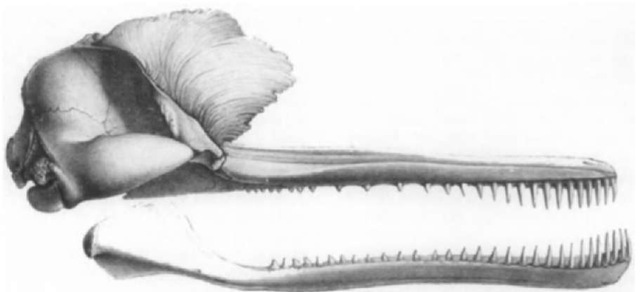The term “river dolphin” classically includes among the living species the boto (Inia geoffrensis), the franciscana (Pontoporia blainvillei), die baiji (Lipotes vexillifer), and the Indian river dolphin (Platanista gangetica). The boto resides in the freshwater rivers of the Amazon and Orinoco drainage, the Indian river dolphin in the Indian subcontinent rivers of the Ganges and Indus River systems, and the baiji in the Yangtze River. However, the franciscana is a “river dolphin” that lives in the coastal marine environments of eastern South America. To add confusion to this already perplexing terminology, several species of distantly related “oceanic dolphins” (family Delphinidae) such as the Irrawaddy River dolphin (Orcaella brevirostris) live in freshwater as well as in the ocean.
In former times, scientists classified these four living genera of “river dolphins” together into the family Platanistidae nestled within the superfamily Platanistoidea based more or less on the following logic: they all have long, narrow jaws with primitive architecture of the skull relating to their jaw closing muscles (Fig. 1) and they all inhabit freshwater (the franciscana was described from a specimen found in the mouth of the La Plata River).
The evolutionary status of the superfamily Platanistoidea is problematic in this classical usage. However, virtually all modern phylogenetic analyses indicate that Platanista is not closely related to the other extant river dolphins. The only character that appears to unite the river dolphins is the presence of a long mandibular symphysis, a feature that seems to have evolved in parallel. Consequently, the river dolphins have been split into two clades: the Platanistidae and the Iniidae.
I. Family Platanistidae
The modern members of this taxon include the river dolphins of die Indian subcontinent of die genus Platanista. These riverine cetaceans have an extremely long snout widi teeth of the greatest lengdi at the end of the snout. In this regard, Platanista resembles the crocodilian gavials that inhabit the same waters. Platanista is also called die blind river dolphin for it lacks a functional eye lens and dierefore cannot discern detailed visual images, only degrees of fight and dark. As diis dolphin inhabits waters that are consis-tendy turbid, sight has limited value. Two synapomorphies unite this family, including die distinctive maxillary crests (Fig. 1). These impressive crests that dominate the top of the skull can be seen less formed in die Miocene fonn Zarhachis.
In one recent cladistic analysis, the family Platanistidae fell into a clade with the extinct families Waipatiidae, Squalodontidae, and Squalodelphidae. The Squalodontidae, or the shark-toothed dolphins, are typified by relatively larger shark-like, sectorial cheek teeth with stoutly built skulls to accommodate large jaw muscles. Squalodonts were a rather common and widely distributed group that flourished during the late Oligocene through the Miocene.
II. Family Iniidae
The Iniidae, as defined herein, are united by three distinct morphological synapomorphies. In the classification used here, there are three extant species of river dolphins in the family Iniidae: Inia geoffrensis, Pontoporia blainvillei, and Lipotes vexillifer. Some taxonomists have separated each of these genera variously into its own family. Such splitting does not negate the conclusion that all diese species fonn a clade, but merely reflects one’s interpretation of “how different” the species are from each other.
The Late Miocene or Pliocene Ischyrorhynchus and Saurodelphis from fluvial deposits of South America are considered related to Inia. The only fossil taxon related to Lipotes is Prolipotes based on a fragment of mandible recovered from freshwater Neogene deposits of China. The extinct long-snouted genus Parapontoporia is considered to be intermediate between Pontoporia and Lipotes by some workers and similar to Lipotes by others. Parapontoporia is found in Late Miocene to Pliocene marine deposits along the eastern North Pacific where it apparently was quite common.
Figure 1 Skull of the Susu (Platanista gangetica).
The family Iniidae is currently considered most closely related to the Delphinoidea (the modern dolphins, porpoises, and their relatives) by two synapomorphies: the presence of a vestibular sac along the nasal passages and the reduction of the attachment of the ear bones to the skull. These characters provide evidence that the two groups share a common ancestry. In fact, some of the most primitive delphinoids have been classified as iniids in the past.

